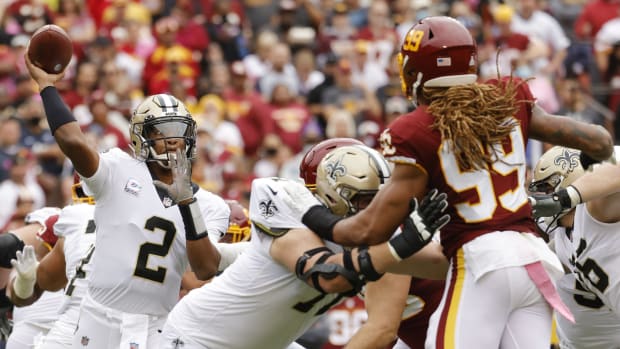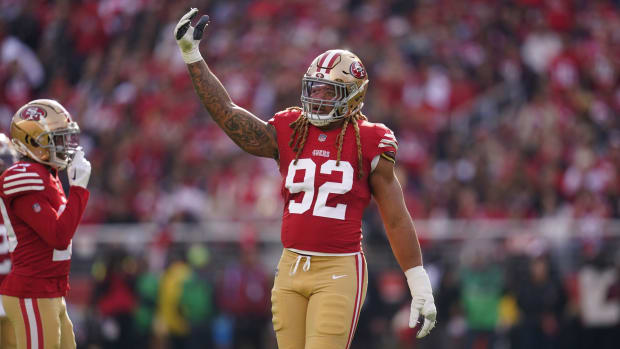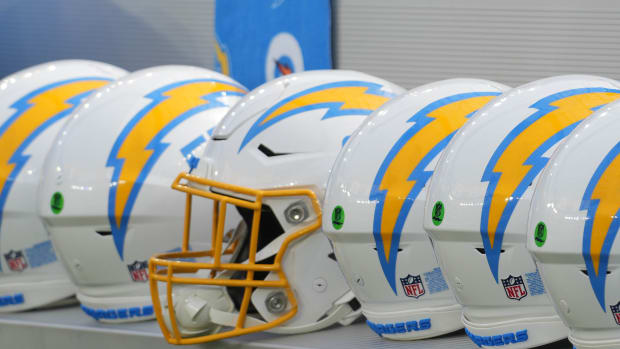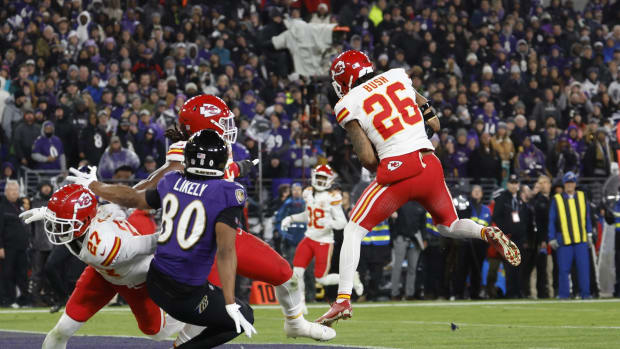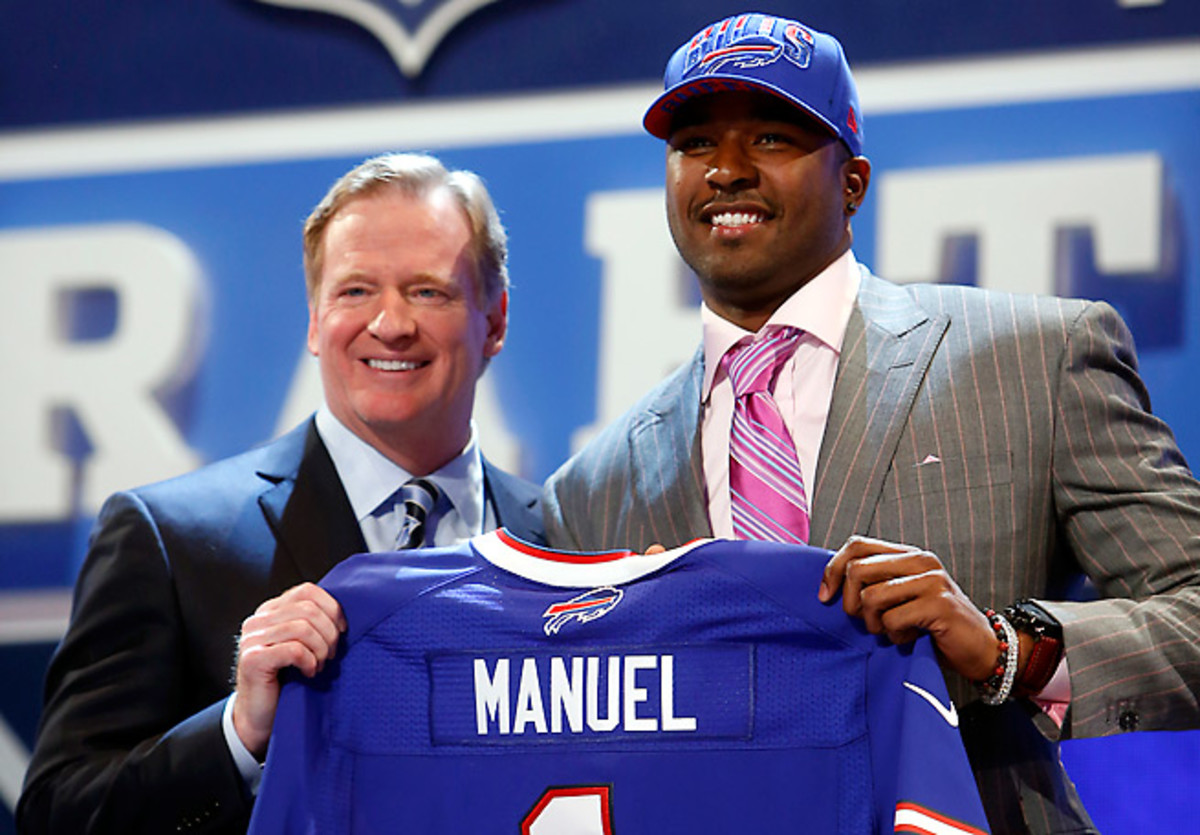
With GM seats burning, Bills and Dolphins go bold; more Snaps
NEW YORK -- Musings, observations and the occasional insight as we digest a less-than-riveting first round of the NFL Draft at Radio City Music Hall ...
? Desperation remains the greatest motivator in sports, and you have only to consider Thursday night's first round of the NFL draft to see its affect. While a host of first-year general managers and personnel decision-makers around the league played things relatively safe, trying to hit solid doubles in their draft debuts, the embattled, win-now-or-else regimes in Miami and Buffalo had to swing for the fences. Yep. Had to.
Dolphins GM Jeff Ireland, correctly feeling that his job is on the line this year, took a sizable gamble, trading up from No. 12 to Oakland's No. 3 pick to select pass-rushing outside linebacker Dion Jordan of Oregon. The Dolphins had an extra second-round pick to play with, but they ignored their glaring need at offensive tackle to take a prospect in Jordan, who not everyone sees as an immediate impact player, Aldon Smith and Jason Taylor comparisons aside.
And then there was Buffalo, which has been searching for a long-term answer at quarterback since Jim Kelly hung up his helmet in the mid-90s. The Bills knew it was time to rectify that little dry spell, and under-the-gun general manager Buddy Nix vowed to get the team a franchise passer. Buffalo got creative in approaching its goal, first moving down from No. 8 to No. 16 in a trade with St. Louis, and then boldly taking Florida State quarterback E.J. Manuel in easily the biggest shocker of the first round.
The Dolphins and Bills, stuck behind the AFC East monolith in New England seemingly forever (10 division titles in the past 12 years), had to take some chances to chase down the dynasty. Miami believes Jordan jacks up a pass rush that will make Tom Brady's life a little more dangerous twice a year, and Buffalo is hopeful Manuel's big arm and athleticism finally brings the Bills quarterbacking into the 21st century.
Juxtapose what Miami and Buffalo did with the comparatively conventional approach taken by many of the new general managers and decision-makers in the first round. Kansas City's John Dorsey, Jacksonville's David Caldwell and Philadelphia's tandem of first-time shot-callers -- GM Howie Roseman and new head coach Chip Kelly -- went for the three top offensive tackles, consensus picks all: Central Michigan's Eric Fisher to the No. 1 Chiefs, Texas A&M's Luke Joeckel to the No. 2 Jaguars, and Oklahoma's Lane Johnson to the No. 4 Eagles.
In Cleveland, where team CEO Joe Banner and GM Mike Lombardi are now in charge, the No. 6 Browns didn't force the issue and do something ultra-risky by taking somebody out of this year's questionable quarterback crop, like West Virginia's Geno Smith. Instead, once the pass rushers they wanted were gone, both Oregon's Dion Jordan and BYU's Ziggy Ansah, Cleveland stuck with the plan to take an impact edge rusher and selected LSU outside linebacker Barkevious Mingo. Same story for No. 7 Arizona, where GM Steve Keim went smart and safe with guard Jonathan Cooper of North Carolina, and No. 11 San Diego, where Chargers rookie general manager Tom Telesco didn't deviate too far from the plan, addressing his team's glaring need by selecting Alabama offensive tackle D.J. Fluker.
Time will tell if Miami and Buffalo get the needed results from the risks they saw fit to take. But it's clear the Dolphins and Bills couldn't afford to play it safe in this 2013 draft. In certain pockets of the NFL, there's desperation in the air. You might not be able to see it, but you can sure feel it.
BURKE: Grades for every first-round pick
? So the Bills got their quarterback, but it wasn't Ryan Nassib; it wasn't Geno Smith; and it wasn't Matt Barkley. As it turns out, it was Manuel who went first overall in the passing set, and maybe we should have seen that coming all along. After all, Manuel was the most read-option friendly quarterback in the draft, and that particular trend has been in the news a bit of late.
We don't know yet whether Buffalo plans to prioritize that part of Manuel's game, but those who said this year's draft wouldn't yield much on the read-option QB front, and that that kind of offense might be a quick-passing fad, perhaps spoke too soon.
GALLERY: First-round quarterbacks who were busts
? The Raiders, with needs everywhere but kicker, had to move out of the No. 3 spot, and they wisely did. Oakland maybe should have gotten a little more from Miami for moving down nine spots, from No. 3 to No. 12, but you could basically throw the draft trade chart out the window this year. This was not a typical draft.
Raiders general manager Reggie McKenzie correctly realized this year's talent pool was deeper than it was special at the top, and from that perspective he wanted to come away with at least two starters springing forth from that No. 3 draft slot. He got one at Miami's original No. 12 spot -- Houston cornerback D.J. Hayden -- and he'll hope to get another Friday night with the No. 42 pick in the second round.
It was good work by a team that has tons of it left to do on the personnel front.
? Did anybody come further faster in this draft season than Hayden, who went from being a near fatality on the Cougars' practice field last November to the 12th overall pick in this year's first round? There are medical concerns going into every draft, but Hayden's situation was so unique -- he nearly bled to death when a vein near his heart tore -- that the NFL didn't even know how to quantify his situation for most of the spring.
But once Hayden got a clean bill of health, the league started realizing he was a fairly unique talent as well: aggressive and hard-hitting, good in press coverage and capable of closing ground and making the receiver earn the reception. The Raiders loved him the more they studied him, to the point where Oakland was said to be seriously considering him at No. 3 if it didn't work out its trade with Miami.
? Break up the Vikings, who walked away with almost one tenth of the players selected in the first round, all in a span of seven picks. Working exclusively in the last third of the round, Minnesota filled major needs at defensive tackle (Florida's Sharrif Floyd at No. 23), cornerback (Florida State's Xavier Rhodes at No. 25), and receiver (Tennessee's Cordarelle Patterson at No. 29).
Floyd was the real steal. A lot of us mock drafters had him going third overall to Oakland, and the Vikings somehow got him an astounding 20 spots later, which has to rate as one of the three largest surprises of the night. Floyd gives Minnesota a natural replacement for defensive tackle Pat Williams, who is retiring. Rhodes upgrades the Vikings secondary, which lost veteran cornerback Antoine Winfield in free agency, and Patterson is a lightly experienced but talented big-play receiver who should combine with Greg Jennings to help offset the loss of Percy Harvin in the trade to Seattle.
The Vikings helped both sides of the ball with their big first round, and served notice they intend to repeat their playoff berth of 2012. Some of it was the good fortune that draft night can sometimes bring, but Minnesota was also prepared and ready for making its own luck. Rhodes was the player the Vikings got with Seattle's No. 25 pick, and Minnesota traded back into the bottom of the first round with No. 29 New England, securing Patterson when it saw the opportunity.
I absolutely detest giving out draft grades. But Minnesota gets an A-plus in my book for Thursday's productive haul.
? Let me get this straight: Dallas agreed to move down from No. 18 to San Francisco's No. 31 first-round slot, with only a third-round pick (No. 74) thrown the Cowboys' way for their trouble? Wow. Not exactly recreating the Herschel Walker fleecing of the Vikings in 1989, were you Jerry Jones?
? While I agree the Rams gave up quite a bit to go up eight spots and land West Virginia receiver Tavon Austin, that's what a team with two No. 1 picks can do if it has a conviction about a player, and St. Louis loved it some Tavon from day one of this NFL draft season.
St. Louis shipped its 16th overall pick to Buffalo to get to No. 8 for Austin, also throwing the Bills a second-rounder (No. 46), a third-rounder (No. 78) and a seventh-rounder (No. 222); with the Rams getting the Bills' 71st overall pick in the deal as well.
You can't do that every year, but Austin was one of the few offensive playmakers in this draft, and he's just what the Rams needed with the loss of receiver Danny Amendola in free agency. The Rams offense is built to play fast in their dome, and Austin gives St. Louis a weapon who should be a matchup nightmare for opposing defenses.
Clearly, the NFC West is where it's at in 2013. With the Rams' moves -- they also took Georgia linebacker Alec Olgetree at No. 30 after trading down from No. 22 with Atlanta -- the division is even more of a three-team race this season. Don't forget, St. Louis beat both San Francisco and Seattle last season, going 4-1-1 in the NFC West. With the acquisition of Austin, the Rams took a step toward combating the height that Seattle cornerbacks are known for. The Seahawks like their cornerbacks tall, but they might not be able to find the vertically-challenged Austin. And to think St. Louis has another pair of first-rounders to play with again next year, thanks to last March's Robert Griffin III blockbuster with Washington.
? Chip Kelly went for a speed guy, what a shocker. Oklahoma's Lane Johnson is one of the quickest, most athletic offensive tackles we've ever seen, so of course Kelly had to have him. The former Oregon coach is going to push his up-tempo offense on the Eagles, and Johnson was obviously someone Kelly felt would help set the pace. He's not a race jack-rabbit, but the idea is similar.
? Smart move, Arizona Cardinals. The Redbirds took Jonathan Cooper at No. 7, making him the first guard selected in the top 10 since New Orleans picked Chris Naeole in 1997. Arizona rightly decided if it didn't get better up front, nothing else it did on offense would matter this season.
? As I spoke to league sources in the past few days and asked them what would make the difference for Central Michigan's Eric Fisher over Texas A&M's Luke Joeckel in Kansas City at No. 1, I kept hearing the same phrase: nasty. Fisher has some nasty in his blocking and his playing style, and Kansas City didn't see quite so much of that in Joeckel. That scrappiness on Fisher's part is what apparently separated the two elite tackles, prompting the Chiefs to lean toward the player who was less celebrated and played in the smaller Mid-American Conference.
? When the curtain dropped on the first round Thursday night, no one had stepped up to claim either Notre Dame linebacker Manti Te'o or West Virginia's Geno Smith, who were only the two most talked about and overly dissected prospects in this year's draft.
And you know what that means: We've got at least one more day to keep talking Te'o and Geno. Oh, joy.

































